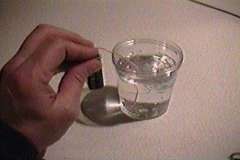

Early balloons, that didn't depend on hot air, used the gas hydrogen for lift. Later on hydrogen was replaced by helium as the gas of choice. Hydrogen gave good lift and was cheap to get, but was also very explosive. Hydrogen is the most plentiful element in the universe and can be made by splitting a molecule of water apart into two atoms of hydrogen and one atom of oxygen. Here's how you can do it at home.
STEP 1: Get two pieces of wire about six inches in length each. Strip off any of the insulation leaving only the metal core.
STEP 2: Find a nine volt battery.
STEP 3: Get a glass filled with water and mix in a couple of teaspoons of baking soda (If you don't have baking soda you can use salt instead).
STEP 4: Wrap the wires around the battery terminals and then dip the free ends of the wires into the water.
STEP 5: Observe the bubbles rising from the wires. The water is being split by the electric current into the gases oxygen and hydrogen. These are the bubbles that you observe.
Warning! The amount of hydrogen produced by this experiment is to small to be dangerous, but don't try to gather the bubbles of hydrogen or oxygen. Let them disperse naturally into the air.
Copyright Lee Krystek 1996. All Rights Reserved.